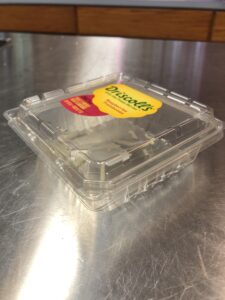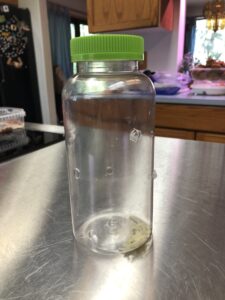I hope y’all are having a smooth transition into July. It has been a heck of an early summer. Between the wildfires, the smoke, the fireworks, and the heat, many people and their pets are struggling to do their typical outdoor activities safely and securely.
And for many dogs, that decrease in time sniffing, exploring, stretching their legs, and moving their bodies can mean we see more shenanigans indoors.
So this month, for our enrichment challenge, we challenge you to explore at least 1 new active foraging toy. We can engage our dog’s senses and get their body moving inside too! Foraging toys can take a lot of forms, some stationary, some relaxing, and some more active.
Let’s talk about some suggestions for trial and eval with your pet, as well as some activities that are staples in my house!
A Note About Safety
Whenever you’re trialing new activities, make sure that your pet has active supervision. While you’re learning how your individual pet will use a device or activity, it is best to make sure everyone is safe.
For example, I’ve watched Griffey knock furniture over trying to get a piece of food that fell behind. That means that when he’s doing some more active toys, he needs to be in a room with very stable items. Some dogs shred and ingest instead of shred and drop, and we’re not looking for obstructions! While you learn about your own pet, take the time actively supervise.
Alright, let’s get into some tips and activities from my home.
Tip #1: Reduce, Reuse, Recycle
I’m a HUGE fan of using my recycling to provide my dogs with opportunities to do their doggiest dog stuff. I have a few manufactured toys (you’ll see some below!) that are staples in our rotation, but a lot of the activities I do with my dogs come from things I find around the house. And let’s be honest, with the cost of things right now, utilizing things I already have takes priority!
For example, while most people might see a simple berry container, I see a lightweight, pre-holed alternative to the Kong Wobbler. This isn’t going to be an appropriate toy for dogs who ingest foreign objects or have a tendency to shred and destroy because the plastic might be sharp, but for my pups, it is safe and can be used by my 11-pound, senior lady when manufactured toys might be a little too heavy.

Two-liter bottles, milk jugs, plastic vitamin containers, and more are great options for slightly larger dogs. Carefully add some holes into the bottle, and you’ve got yourself a toy that your dog can bat around to get breakfast or dinner to fall out. Again, know your pet and how they will use the toy! For some dogs, even these larger items are going to be too easily destroyed, and they do need something a little more heavy-duty. You want to make sure that the lid is nice and secure, and that there isn’t a way that a part of your pet’s body (like their muzzle or head) can get stuck. And for dogs with sound sensitivity or noise phobia, they may prefer the manufactured rubber or silicone options since they are much, much quieter.

Cardboard and paper are awesome options to get our pets shredding and dissecting. While they are ripping things apart, you can watch the dog engage so many different muscles in their body and navigate a lot of different positions. Again, for pets that are known to ingest foreign objects, I often recommend speaking to your vet to explore possible edible options, like greens. And if you’re looking for easier cleanup, someone in the Enrichment for the Real World Facebook Group shared a tip to put down a sheet for your pet to destroy on. When they are done, you can pick up the sheet and shake it off in the bin!
View this post on Instagram
Tip #2: Get Creative!
That is if you want to. Knowing what works for your pet and pulling out those well-established activities is fantastic. It can help make the process more sustainable and can take a lot of the cognitive work out of the plan for the human.
But, part of what I love about animal care is finding creative, sustainable solutions to help our pets be the birdiest-bird, the doggiest-dog, or the cattiest-cat. It gives me an opportunity to engage in mental exercise, problem-solving, and creativity. While I watch my dogs move around in space and spend their time, or birds engage with the world around them, I can ask myself, “How can I help do <insert behavior here> in more ways that are healthy, safe, and appropriate?”
And remember, just because your pet can reliably do the activities, that does not inherently mean that it is less enriching. Things being challenging doesn’t inherently make them more enriching. We observe their behavior, both during and after to judge that! My dogs have been using the same lick mats for 2 years, and they are every bit as effective now as the day we got them! These are my go-to’s when I’m dang tired.
Tip #3: Meet Your Pet Where They Are
I bet we’ve all seen some super cool activity on the internet, tried it out, and our pets didn’t quite engage the way we expected. Maybe they just walked away. Maybe they tried to eat the whole thing. Maybe they tried a little but ultimately gave up. Just because we’re looking to help our pets engage in activities that are species-typical, doesn’t mean they don’t need to be taught what to do. Start by learning where your pet’s skills are, and meet them there. We can work up to doing elaborate, multi-step puzzles (if you and your pet are into that!), but start at a point of success. In Episode 43 of Enrichment for the Real World, Emily shares a story of a dog that needed to be taught to eat off the ground. Because even the things that may seem like the most basic of skills may need a little help to develop.
Laika and Griffey Approved Activities
Remember, each pet is an individual! What is really effective and fulfilling for one, may be another’s absolute nightmare. So, while there are tried and true options in my house, your pet’s preferences might be entirely different! This is where the process of trial and eval will help you get to know your pet, their preferences, and how y’all will work together through their lifetime.
Berry Containers
It is lightweight, it has many holes, and both my dogs can pick it up with their mouths and toss it around, it is quiet, and pretty easy to open, so they may figure out how to pop the top. Laika isn’t a fan of plastic smashing against stuff, so it is a nice option for her compared to really crinkly two-liters. Sour cream or yogurt containers are also a win here!
Closed Top, Mid-Sized Plastic Bottles
These are more of a hit for Griffey than Laika. Laika prefers to engage with toys that aren’t as large as she is, which is reasonable. One thing I really like about this option is that I can really easily change the difficulty depending on the size of the holes and the size of the treats I use. Bigger holes and smaller treats mean he has an easier time knocking things out. If I want to increase the challenge, I can even toss some scrunched-up paper, scraps of fabric, and shreds of cardboard inside to add obstacles.
Kong Genius and Busy Buddy Lines
We have multiple toys from the Kong Genius and Busy Buddy lines, and each of my pets has their preferred toys. They are pretty quiet, at least until Griffey takes it to the top of the stairs and throws it down. They are simple to add treats to, and they come in a few sizes, which is good for Laika and other small dogs. They have much more longevity compared to the DIY options, and I know that my pups aren’t going to shred and ingest them, so they are a nice activity when I need to leave them unsupervised.
Kong Wobbler
Remember when I said, “What is really effective and fulfilling for one, maybe another’s absolute nightmare”? That’s the Kong Wobbler in my house. Griffey loves it. He gets all prancy and woo-woo-ey when the wobbler comes out, and Laika does not agree. It is big, it is heavy, and as Griffey is knocking it around it makes a lot of noise, and furniture may fall over. It is just a bit too much chaos for Laika, and that’s okay! While he’s playing with this wobble in one room, Laika is able to do her preferred activity in another.
View this post on Instagram
Shreddables and Destructibles
If you’ve been around, you know that we do a lot of these in my house. I have two dogs who turn their toys into frayed carcasses of what once was:
View this post on Instagram
And because toys aren’t cheap, we tend to offer a lot of options that come from our recycling. It lets both our dogs engage muscles through their whole body, and participate in shredding, dissecting, and ingesting (of the treats inside, not the paper).
View this post on Instagram
Doubling Up!
You may have noticed that in many of the videos, my dogs have more than one option available. This is a small, easy way that can provide my dogs with more agency in their day-to-day life. They can pick which toy to engage with first, and they can choose to switch back and forth. They can choose between sniffing, and batting the toy around. When one thing is too challenging, they can take a break, go do one of the other activities, and then come back. And it gives me a really nice opportunity to observe what they choose to engage with first, or for longer, or which activity leads to different body language.
Now What?
- Take at least one of the activities on this list, or that you found somewhere else, that is safe for your pet, and give it a try! Make sure to supervise while they are using the new activity to make sure that it is as safe as you expected!
- Make sure to follow us on Instagram for even more activities and enrichment-related content!
- And if you’re looking for some of the options we recommend that you can purchase, you can check out our Recommended Products page! *Disclaimer: this page contains affiliate links. We receive a small commission for purchases made through these links at no extra cost to you. This helps us continue to put out free content to help you and your pets live more harmoniously!*

